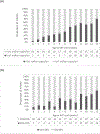Hospitalization among infants who initiate antiretroviral therapy before 3 months of age
- PMID: 36695356
- PMCID: PMC9881839
- DOI: 10.1097/QAD.0000000000003422
Hospitalization among infants who initiate antiretroviral therapy before 3 months of age
Abstract
Introduction: Studies examining hospitalization among infants with HIV in resource-limited settings, in the context of early infant diagnosis and early antiretroviral therapy (ART) initiation, are limited.
Methods: We used routinely collected data on infants who initiated ART aged <3 months (Western Cape province, South Africa; 2013-2017) to describe hospitalization from birth until 12 months post-ART initiation. Record reviews were additionally performed at three tertiary-level facilities. We used mixed-effects Poisson regression to examine factors associated with hospitalization.
Results: Among 840 infants, 579 (69%) were hospitalized; 36% had >1 hospitalization. Median age at ART initiation decreased from 57 days (interquartile range [IQR] 22-74; 2013-2015) to 19 days (IQR 5-54; 2016-2017). Early neonatal hospitalization (age <7 days) occurred in 271 infants (32%) and represented 24% of hospitalizations (272/1131). Overall, 443 infants (53%) were hospitalized at age ≥7 days, including 13% with hospitalizations pre-ART initiation, 15% pre and post-ART initiation and 25% post-ART initiation. Excluding early neonatal hospitalizations, initiating ART at older age vs. age <1 week was associated with higher hospitalization rates: adjusted incidence rate ratios (95% confidence interval) were 1.86 (1.31-2.64); 2.31 (1.62-3.29) and 2.47 (1.76-3.46) if ART initiation age was 1-4 weeks; 5-8 weeks and 9-12 weeks respectively. Among infants whose hospital records were reviewed, reasons for early neonatal hospitalizations mostly related to prematurity or low birthweight (n = 46/60; 77%) whereas hospitalizations at age ≥7 days were mostly due to infections (n = 206/243; 85%).
Conclusions: Earlier ART initiation is associated with lower hospitalization rates. High hospitalization rates, despite initiation age <3 months, is concerning.
Copyright © 2022 Wolters Kluwer Health, Inc. All rights reserved.
Figures


Comment in
-
Days and weeks do matter: a call for testing infants at risk of HIV acquisition at birth.AIDS. 2023 Mar 1;37(3):545-546. doi: 10.1097/QAD.0000000000003468. AIDS. 2023. PMID: 36695365 No abstract available.
References
-
- Sherman GG, Lilian RR, Bhardwaj S, Candy S, Barron P. Laboratory information system data demonstrate successful implementation of the prevention of mother-to-child transmission programme in South Africa. South African Med J. 2014. Jan 20;104(3):235. Available from: http://www.samj.org.za/index.php/samj/article/view/7598 - PubMed
-
- UNAIDS. UNAIDS Fact Sheet - World AIDS Day 2021. [Internet] [cited 2022 May 5]. Available from: https://www.unaids.org/sites/default/files/media_asset/UNAIDS_FactSheet_...
-
- UNICEF. Elimination of mother-to-child transmission - UNICEF DATA [Internet] [cited 2022 May 4]. Available from: https://data.unicef.org/topic/hivaids/emtct/#status
-
- UNAIDS. HIV estimates with uncertainty bounds 1990-Present [Internet] [cited 2022 May 4]. Available from: https://www.unaids.org/en/resources/documents/2021/HIV_estimates_with_un...
-
- Bourne DE, Thompson M, Brody LL, Cotton M, Draper B, Laubscher R, et al. Emergence of a peak in early infant mortality due to HIV/AIDS in South Africa. AIDS. 2009. Jan;23(1):101–6. Available from: https://insights.ovid.com/crossref?an=00002030-200901020-00014 - PubMed
Publication types
MeSH terms
Substances
Grants and funding
LinkOut - more resources
Full Text Sources
Medical

